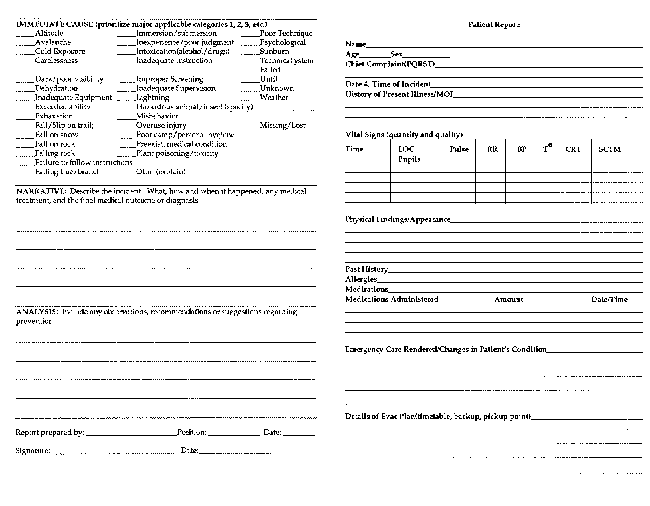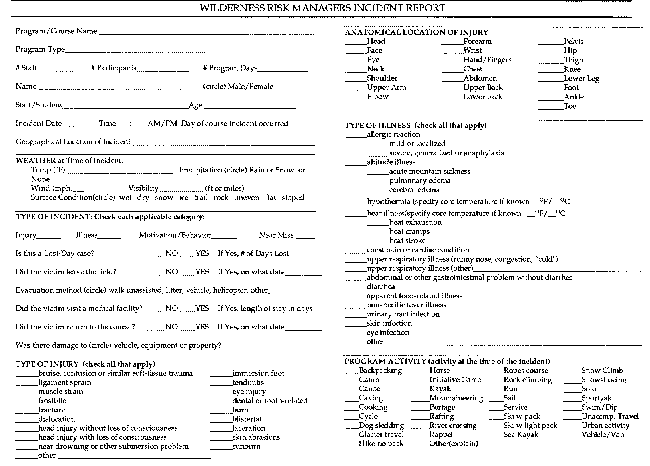 Full GIF version of page 2 (33K)
Full GIF version of page 2 (33K)
This report was designed with the intent that it be useful for program records and incident documentation as well as the incident data gathering needs of this project. The form itself can be used both to record pertinent incident data, and essential patient information. As a reminder, statements of witnesses are recommended information for a program to obtain in the event of an incident, but are not necessary to submit to this database.
Reports for each incident should be submitted to:
Association for Experiential Education
Wilderness Risk Managers Incident Report
2305 Canyon Boulevard, Suite #100
Boulder, CO 80302
FAX 303-440-9581
Tel. 303-440-8844
Accurate and complete reports are essential to the strength of this database. The following instructions are provided for completing the Incident Report Form. Questions about completing the incident report should be directed to the AEE Office (303-440-8844)
A reportable injury or illness meets one or more of the following criteria
Incident Report Forms
Select the appropriate file save as option from your Web
browser to save the following files to disk.
 Full GIF version of page 1 (65K)
Full GIF version of page 1 (65K)
 Full GIF version of page 2 (33K)
Full GIF version of page 2 (33K)
Program/Course type
This should be a brief description of the type of program, i.e. outdoor adventure, therapeutic, adjudicated youth, etc.
Name
The name of the person involved in the incident. This is included for completeness of the program’s records. The name can be omitted or covered on forms submitted to the WRMC.
Age, Gender and Staff or Participant, Incident date, Time
Self explanatory
Day of course incident occurred
The number of days the participant was in the field prior to this incident.
Program,Course area
This should be a geographical description of the program area; e.g. Wyoming, Bighorn Mountains, Mt. Baldy or Vermont, Green Mountains, Long Trail.
The weather at incident time
Air temperature, wind speed, precipitation amount and type, visibility
Type of Incident
An incident may result in injury, illness, motivation/behavioral outcome or a near miss. Check each applicable category. Injury includes damage to property e.g. van,
kayak.
Lost day cases
A lost day case occurs if a participant missed one or more days of activity beginning with the day following the incident, or if it causes loss of more than half of the day of the incident for morning mishaps.
Near miss incidents
Motivation or behavioral incident
Examples would be unwillingness to participate, running away, alcohol or drug use, assaultive behavior, suicidal ideation, or an emotional or psychological situation that compromises the students ability to participate in the program.
Evacuations
Evacuations are incidents in which the person leaves the field as a result of the incident. There are several levels of definition which aid in defining the seriousness of the incident:
Property damage
This is included to make the program’s records complete for insurance purposes. Circle if property, equipment or vehicle damage occurred.
Type of injury
All the applicable categories should be checked. Please specify the injury if the “other” category is checked.
Anatomical location of injury
All the applicable categories should be checked.
Type of illness
All the applicable categories should be checked. Please specify the illness if the “other” category is checked.
Activity at incident
The applicable categories should be checked describing the program activity the person was engaged in at the time of the incident.
Immediate cause of incident
This is a list of common incident causes in outdoor programming. Prioritize the applicable categories 1, 2, 3, etc.
Narrative
Describe the incident. What, how and when it happened, any medical treatment, the final medical outcome or diagnosis.
Analysis
Include any observations, recommendations or suggestions regarding prevention.
Patient report
This section is included to make the program’s records on the incident complete and is designed to serve as both a field report form or “run sheet,” a record of medical assessment and treatment, and corresponds to the Field Report Form carried in many first aid kits.
This page is maintained by Rick Curtis Director, Outdoor Action Program. Rcurtis@.princeton.edu
Copyright © 1998 Association for Experiential Education.